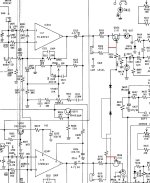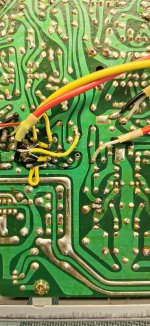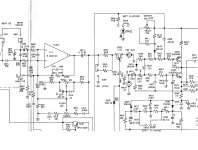so the muting circuit is the issue.
I removed both of those 10m resistors and shorted the d/s of each FET and the click is gone
I removed both of those 10m resistors and shorted the d/s of each FET and the click is gone
so the muting circuit is the issue.
It would appear so. What you have done proves the point and that this is a design defect or characteristic if you prefer. Why not try and rearrange the circuit to be like the preamp version you showed. Turn the diodes around and alter the 10meg connections to suit.
so i made the mod, and no clicks now.
the only thing is you have the buzz in there on start up, a bit like you get with the 3020A(where it has underated caps in the circuit), but that doesnt have a low level switch, so its a different set up.
so could this be because i havent changed the FETS to the other type?
but the click has def gone. Without the muting you just get a small thump as you would expect, so I'm not sure if it's better just like that
the only thing is you have the buzz in there on start up, a bit like you get with the 3020A(where it has underated caps in the circuit), but that doesnt have a low level switch, so its a different set up.
so could this be because i havent changed the FETS to the other type?
but the click has def gone. Without the muting you just get a small thump as you would expect, so I'm not sure if it's better just like that
Attachments
Last edited:
im going to put it back the way it was, as i have at least proved thats what it was, and dont want to ruin a perfectly good amplifier
good exercise though
good exercise though
Fair enough. It's possible the hum is being introduced via the FET gates and whatever ripple/noise is present on the drive voltage to the gate from the muting part of the circuit.
so im not going to give up on this one becuase there has to be a reason the low level switch clicks
I have 3 of these amps, 2 dont click, and the one im working on does, so there has to be a reason
the infra switch also clicked when depressed, but i resolved that by replacing the 2 caps in the audio path, but doing the same with this switch doesnt help.
so i took the switch out of the one that doesnt click and put it in this one, and it still clicks
Ive by passed the muting circuit, so its not anything to do with that.
ive checked the 2 resistors that are directly in circuit with the switch, and its not them.
Its very odd, but im not going to give up on this untill i find out what it is.
I have 3 of these amps, 2 dont click, and the one im working on does, so there has to be a reason
the infra switch also clicked when depressed, but i resolved that by replacing the 2 caps in the audio path, but doing the same with this switch doesnt help.
so i took the switch out of the one that doesnt click and put it in this one, and it still clicks
Ive by passed the muting circuit, so its not anything to do with that.
ive checked the 2 resistors that are directly in circuit with the switch, and its not them.
Its very odd, but im not going to give up on this untill i find out what it is.
Attachments
Clicks usually occur where there is an abrupt change in DC conditions, so the first thing to look at is the DC conditions on the switch. SW9 in the diagram is ground referenced and so any DC voltage present on the other two pins of the switch will cause a click when the switch is operated.
You should see 0.0000 volts on all three pins of the switch in either position.
You should see 0.0000 volts on all three pins of the switch in either position.
Hard to say. First you have to determine if that is what is happening (DC) and if it is then look for possible paths where it could come from.
The 10 meg to the gate of the FET is a possible route. You would need to remove the FET completely and link D and S to prove that theory. It all depends on the voltage applied to the 10 meg. If it was 25 volts then you have 25 volts in series with the FET G/S junction (like a diode) and then 6k8 or 680 ohm on one side of the FET and 220k on the other side (input to the power amp) The 220k is orders of magnitude higher than the 6k8 and 680 ohm so can be disregarded.
Work the current out in the 10meg and 6k8 and calculate the volt drop across the 6k8. That volt drop then gets pulled down via a 680 ohm when you operate the switch. So you get a step chjange in voltage and a click I suspect.
Try without the FET and prove it.
The 10 meg to the gate of the FET is a possible route. You would need to remove the FET completely and link D and S to prove that theory. It all depends on the voltage applied to the 10 meg. If it was 25 volts then you have 25 volts in series with the FET G/S junction (like a diode) and then 6k8 or 680 ohm on one side of the FET and 220k on the other side (input to the power amp) The 220k is orders of magnitude higher than the 6k8 and 680 ohm so can be disregarded.
Work the current out in the 10meg and 6k8 and calculate the volt drop across the 6k8. That volt drop then gets pulled down via a 680 ohm when you operate the switch. So you get a step chjange in voltage and a click I suspect.
Try without the FET and prove it.
Bypassing it (if you mean linking it out) won't work because the Gate is still in circuit and will conduct G to S and G to D when forward biased. You have to pull the FET for this one.
ok so no clicking with the FET removed, which proves you are right, but why on some amps and not others.Quality of product?
Ill try a new pair of FETS and see if that makes any difference
Ill try a new pair of FETS and see if that makes any difference
No difference with brand new FETS.
well that solves that then, and with the FET removed it makes less noise when the mains switch is depressed, so its kind of pointless being there realy isnt is, at least in this instance
so im going to leave them out and D/S shorted
well that solves that then, and with the FET removed it makes less noise when the mains switch is depressed, so its kind of pointless being there realy isnt is, at least in this instance
so im going to leave them out and D/S shorted
ok so no clicking with the FET removed, which proves you are right, but why on some amps and not others.
I haven't an answet to that because the theory tells me it should click... and it does.
On the working circuits you will have to measure the actual voltage applied to FET gate (the other end of the 10 meg). Does the one that does not click have an additional reverse biased diode in series with the gate?
- Home
- Amplifiers
- Solid State
- NAD 3130 low level switch clicking when depressed/released


